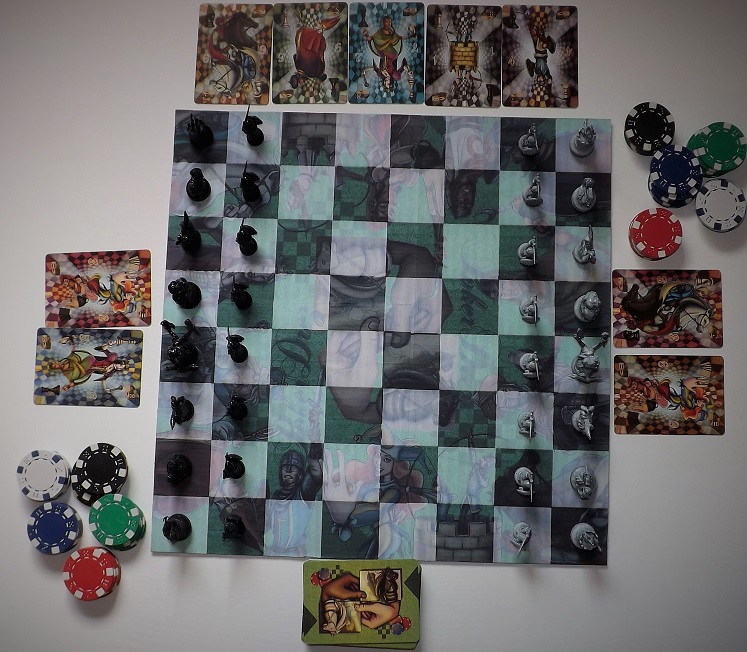PokerDrez
The basis of PokerDrez remains chess, but the possible piece to move will depend on the cards available to the players at each moment.

PokerDrez
Introduction
Two kingdoms in conflict for centuries repeatedly engage in hostilities on a checkered black and white terrain, guided by the whims of human gods who manipulate them.
Some of those deities learn all the initial situations of the battles, which always start the same way, and end up too often winning against less experienced ones, making the confrontations predictable and, in many cases, completely unbalanced.
Now the joker, responsible for the entertainment at the court, who had remained on the sidelines until now, has played a heavy prank on anyone who wants to intervene in this war.
He put all the members of the kingdom to sleep (both the white and black pieces), and they can only be temporarily awakened with the corresponding card to play their role during their turn.
Only the joker card can awaken any piece, and any card can awaken the king.
The randomly dealt cards ensure equal opportunities among opponents, who must now, in addition to showcasing their intelligence, manage their resources, demonstrate their memory, and mislead their opponents about their true hidden forces.
Poker + ajeDrez (chess in Spanish)
The foundation of PokerDrez remains chess. All its rules are preserved; only the potential pieces to move are limited by the cards available to the players at each moment. It’s no longer possible to always choose the best-prepared move because there may not be the necessary cards to execute it or secure a safe position after discarding some of them.
Poker, just like in regular poker, in PokerDrez, you’ll have to mislead your opponent about your hidden cards. At times, you’ll need to make them believe you have more cards to support a move you’ve made; at other times, you’ll try to trick them into taking action against you, thinking you won’t be able to defend yourself, only to counterattack strongly.
Will you be able to conceal your burst of joy when the card you draw from the deck is a Joker?
Do you have the memory to recall previously played cards and foresee what your opponent might have?
Can you guess the cards they hold based on the moves they are forced to make when there might be other, more logical options?
Is it a mistake on his part, or a strategy to throw you off?
Componentes
A classic chess board
A set of classic chess pieces
Or those supplied by us.
A six-sided dot die
A Pokerdrez card deck
(56 linen cards in their shrink-wrapped case, Poker size, The US Playing Card Company quality: the creators of Bicycle cards)
9 joker cards
9 queen cards
9 rook cards
9 bishop cards
9 knight cards
9 pawn cards
2 neutral cards
As can be seen in the above list, for each of the figures, there are 9 cards, each with a different number and color distributed as follows:
1: Grey
2: Red
3: Magenta
4: Purple
5: Blue
6: Yellow
7: Cyan
8: Orange
9: Green
This numbering and coloring serve no other purpose in Pokerdrez than to help opponents more easily remember which cards have already been used.
It is recommended to use two decks of cards to ensure the ability to finish the game without having to switch to Chess-only mode.
Rules
The rules of the game and the movement of the pieces are the same as in classic chess. The main variation is that to move a chess piece, you need to have and discard a corresponding card for that piece.
Special rules:
Joker: wildcard, allows moving any piece.
To move the king, you can use any card, but you still have to discard one.
Castling: considered as a single rook move.
Neutral or treacherous cards: can be exchanged at any desired moment for a new card, either from the deck, the common cards, or the opponent’s own cards.
Similar to Poker, especially in its Texas Hold’em variant, each player always has two cards (own cards) that remain hidden from the opponent and can only be used by them to move their chess pieces.
Another five cards (common cards) are placed face up and can be used on their turn by either player for the same purpose as their own two cards. The rest of the cards are placed face down in a deck and will replace the ones used.
If at any point, especially at the beginning of the game, a player has no own or common cards to move any of the pieces, and the roll of the die doesn’t help either (see below), they have to show their cards to the opponent to prove it, discard them, and draw two new ones.
Before starting the game, opponents can get rid of one of their own pawns if they wish. If the pawn in front of a rook is eliminated, for example, that rook can immediately enter the game, and the cards for rooks are useful from the first move.
In the middle of the game, if at any point, one of the players runs out of all pieces of a certain type, for example, both knights are captured, the knight cards become wildcards for them. In other words, they can use them to move any piece just like using the Joker.
The die
Traditionally, players defending the black pieces have suffered the disadvantage of remaining on the defensive from the beginning of the game because the white pieces make the first move, taking the initiative.
To compensate for this unfair inequality, a die has been introduced in PokerDrez. It starts in the possession of the player with the black pieces until they decide to use it, at which point it passes into the hands of their opponent.
There may be a moment when, among the available cards, both own and common, there is none suitable for making the necessary move.
It is at this moment that the die fulfills its intended purpose. The player who possesses it can roll it and, if they choose, move a corresponding piece to the number they rolled, without having to discard any specific card during that turn.
The equivalence between the die numbers and the pieces is expressed on the cards themselves and is as follows:
Pawn: one
Knight: two
Bishop: three
Rook: four
Queen: five
Joker: six
Once the die is rolled, whether the result is used to move a piece or not, the player must pass it to their opponent, who will keep it to use whenever they wish.
The match
Players will move their pieces in alternating turns.
In each turn, the player must:
- Discard a card, either from their hand or from the common cards. After showing it to the opponent, this card must be placed face down in the discard pile and will not be used again.
- Move one of their pieces corresponding to that card, as explained above. This move must comply with the rules of chess.
- Then, draw a card from the deck. If they used a common card, they must replenish it by choosing, from the three cards they have at that moment in their hand, which one to return.
Alternatively, if the player has decided to roll the die, they can use the result to move the corresponding piece. It is important to specify that the player is not obligated to use the result of the die, and they can move another piece as long as they use a card to support it.
The game will continue with these rules until the deck is empty. From that point onward (even if there are still common and own cards for both players), the game will continue with the rules of traditional chess. Players can move any piece they consider necessary without using any cards for it.
It is recommended to play with two PokerDrez decks (112 cards) to decrease the likelihood of reaching this moment and to continue enjoying the excitement provided by the cards until the end of the game.
End o the game
The game ends when the opponent’s king is checkmated, meaning that the opponent, with the cards at their disposal, cannot make any move that would free the king from check.
Although it may seem redundant, it is important to emphasize that the king should never move to a position where it is in check, even when it is known that the opponent does not have cards to move the piece attacking the king.
If at any point a player has no possible moves considering the cards they have, but they are not in check, the game ends in a draw. It is considered a stalemate.
It is important to note that the king can use any card to move.
Variant (not suitable for minors) Are you excited to bet?
Establish with your opponent a minimum and maximum bet, for example, €5 and €20.
The game always starts with the minimum bet, meaning the winner takes it. If there is a tie, the bet is returned to both players.
During their turn, any player can increase the bet, and the opposing player must either accept it or raise it to avoid losing.
Each time a player increases the existing bet, they are committing to winning the game. If they fail to win (if they lose or tie), they will lose the bet.
Once the previously established maximum bet is reached, no more betting is allowed.
It is recommended to use poker chips (not provided) to keep track of the current bet at all times.

